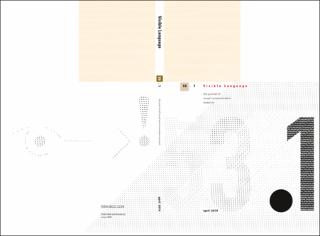| dc.contributor.author | Klevgaard, Trond | |
| dc.date.accessioned | 2022-07-14T07:50:34Z | |
| dc.date.available | 2022-07-14T07:50:34Z | |
| dc.date.created | 2019-05-24T14:30:21Z | |
| dc.date.issued | 2019 | |
| dc.identifier.citation | Visible Language. 2019, 53 (1), 110-131. | en_US |
| dc.identifier.issn | 0022-2224 | |
| dc.identifier.uri | https://hdl.handle.net/11250/3005322 | |
| dc.description | "Visible Language is a peer-reviewed design journal that advocates the potential for the research and practice of visual communication to enhance the human experience. Published by the School of Design at the University of Cincinnati, Visible Language balances artfulness with science, innovation with respect for human patterns of use, evidence-based research with intuitive exploration,
and technology with humanity.
_ published 3 times a year: April, September, December
_ double-blind peer review
_ open-access 12 months from publication
_ searchable database of all back-issues on-line
_ acceptance rate below 20%"
http://visiblelanguage.herokuapp.com/ | en_US |
| dc.description.abstract | The orthographic reform program known as kleinschreibung, or writing small, was an integral part of the New Typography of the 1920s and 30s. Commonly associated with institutions like the Bauhaus, or groups like the ring ‘neue werbegestalter’ (circle ‘new advertising designers’), New Typography was also taken up in the work of numerous printers and compositors across Germany and beyond. In Denmark, where common nouns were capitalized then as they still are in German, one proponent of New Typography amongst printers was Typografernes fagtekniske Samvirke (The Compositors’ trade-technical Cooperative). In 1934 this educational society published an annual titled Typografisk årbog 1935 (Typographic yearbook 1935) where it set out how it had chosen to engage with New Typography and kleinschreibung by adapting them to Danish circumstances. This article takes Typografisk årbog 1935 as the starting point for an investigation of the similarities and differences between the German and Danish contexts by tracing their histories of orthographic reform and by linking these to New Typography as practiced in the two countries. | en_US |
| dc.language.iso | eng | en_US |
| dc.subject | Modernisme | en_US |
| dc.subject | Modernism | en_US |
| dc.subject | Designhistorie | en_US |
| dc.subject | Designhistory | en_US |
| dc.subject | Danmark | en_US |
| dc.subject | Denmark | en_US |
| dc.subject | Grafisk design | en_US |
| dc.subject | Graphic design | en_US |
| dc.subject | Typografi | en_US |
| dc.subject | Typography | en_US |
| dc.title | Lower Case in the Flatlands: New Typography and Orthographic Reform in a Danish Printing Calendar | en_US |
| dc.type | Peer reviewed | en_US |
| dc.type | Journal article | en_US |
| dc.description.version | publishedVersion | en_US |
| dc.source.pagenumber | 110-131 | en_US |
| dc.source.volume | 53 | en_US |
| dc.source.journal | Visible Language | en_US |
| dc.source.issue | 1 | en_US |
| dc.identifier.cristin | 1700149 | |
| cristin.ispublished | true | |
| cristin.fulltext | original | |
| cristin.qualitycode | 1 | |
